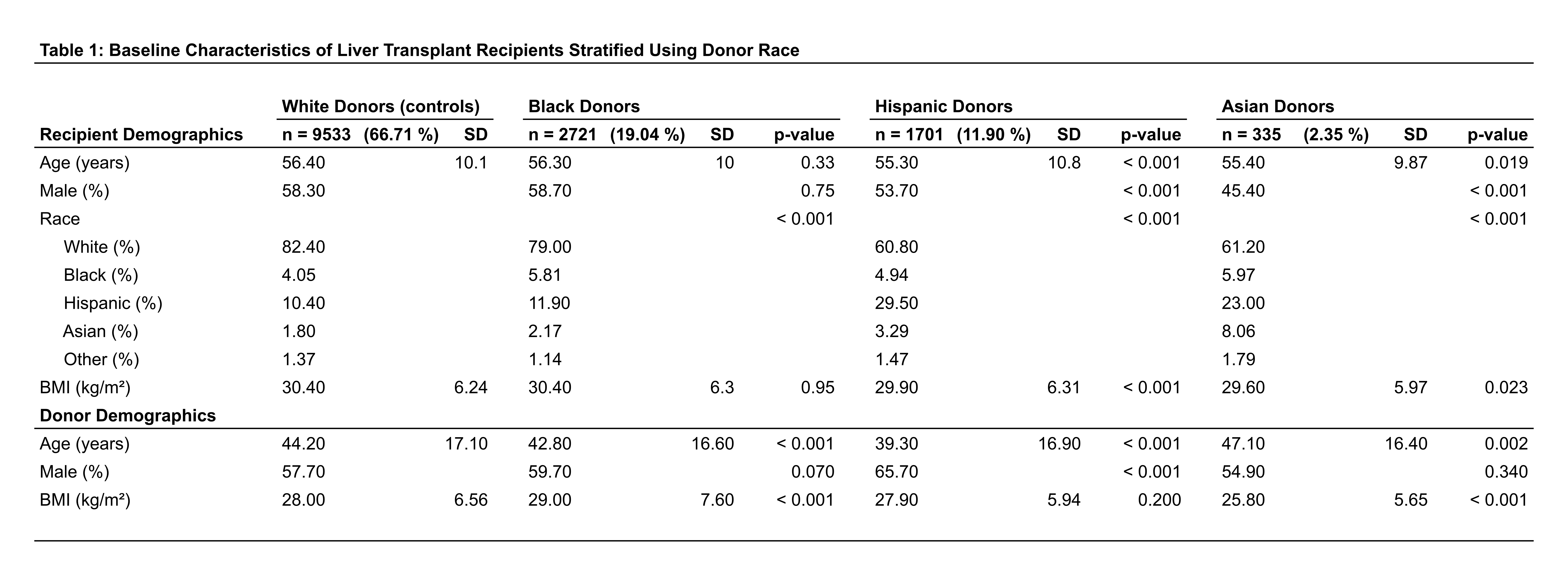The Implication of Donor Race on the Post-Liver Transplant Prognosis of Patients with Nonalcoholic Steatohepatitis: Analysis of UNOS Database
1Department of Gastroenterology and Hepatology, University of Maryland, Baltimore, MD, 2Tufts Medical Center, Boston, MA, 3University of Maryland, Baltimore, MD
Meeting: 2022 American Transplant Congress
Abstract number: 1197
Keywords: African-American, Allocation, Hispanic
Topic: Clinical Science » Organ Inclusive » 70 - Non-Organ Specific: Disparities to Outcome and Access to Healthcare
Session Information
Session Name: Non-Organ Specific: Disparities to Outcome and Access to Healthcare
Session Type: Poster Abstract
Date: Sunday, June 5, 2022
Session Time: 7:00pm-8:00pm
 Presentation Time: 7:00pm-8:00pm
Presentation Time: 7:00pm-8:00pm
Location: Hynes Halls C & D
*Purpose: Prior studies have suggested liver transplant (LT) recipients who receive their grafts from minority donors may potentially suffer higher rates of graft complications. In this study, we use a national registry to evaluate the effects of donor race on the post-LT outcomes of patients with nonalcoholic steatohepatitis (NASH).
*Methods: STAR-UNOS database 2005-2019 was used to select adult patients with NASH/cryptogenic cirrhosis who had undergone deceased donor liver transplant. The cohort was stratified using donor race and was compared to various endpoints using iterative Cox regression analysis.
*Results: From 14290 recipients with NASH, there were 9533 with grafts from White donors, 2721 from Blacks, 1701 from Hispanics, and 335 from Asians. The median follow-up was 3.07 years. Grafts from minority donors were provided more frequently to minority recipients. Comparing recipients with Black donors from those with White donors, there was no difference in age and gender. Having a Black donor was associated with recipient deaths due to cardiac causes (aHR 1.71 95%CI 1.04-2.79) and graft rejection (aHR 2.09 95%CI 1.12-3.89). Recipients of Hispanic donors were younger and more likely to be female than those of White donors. Having a Hispanic donor was associated with higher rates of recipient all-cause mortality (aHR 1.29 95%CI 1.16-1.43) and graft failure (aHR 1.61 95%CI 1.26-2.06), as well as deaths due to infectious causes (aHR 1.50 95%CI 1.19-1.88) and graft hepatitis (aHR 3.30 95%CI 1.26-8.62). Recipients of Asian donors were younger and more likely to be male than those of White donors. Having an Asian donor was associated with higher rates of recipient graft failure (aHR 1.95 95%CI 1.25-3.05), as well as recipient deaths due to graft hepatitis (aHR 5.10 95%CI 1.29-20.1), graft infection (aHR 10.85 95%CI 1.73-68.13), and hepatic artery stenosis (aHR 12.05 95%CI 1.30-111.5).
*Conclusions: This study shows that receiving a graft from any minority donor as compared to White donors is predisposes to compromised post- LT outcomes.
To cite this abstract in AMA style:
Lee DU, Han J, Kwon J, Chang K, Lee K, Fan G, Urranaga N, Maluf D, Bhati C, Shetty K. The Implication of Donor Race on the Post-Liver Transplant Prognosis of Patients with Nonalcoholic Steatohepatitis: Analysis of UNOS Database [abstract]. Am J Transplant. 2022; 22 (suppl 3). https://atcmeetingabstracts.com/abstract/the-implication-of-donor-race-on-the-post-liver-transplant-prognosis-of-patients-with-nonalcoholic-steatohepatitis-analysis-of-unos-database/. Accessed December 30, 2025.« Back to 2022 American Transplant Congress


